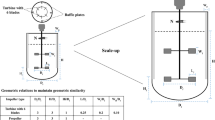Abstract
Packed-bed bioreactors containing activated carbon as support carrier were used to produce H2 anaerobically from a sucrose-limiting medium while acclimated sewage sludge was used as the H2 producer. The effects of bed porosity (εb) and substrate loading rate on H2 fermentation were examined using packed beds with εb of 70–90% being operated at hydraulic retention times (HRT) of 0.5–4 h. Higher εb and lower HRT favored H2 production. With 20 g COD l−1 of sucrose in the feed, the optimal H2 production rate (7.4 l h−1 l−1) was obtained when the bed with εb=90% was operated at HRT = 0.5 h. Flocculation of cells enhanced the retention of sludge for stable operations of the bioreactor at low HRTs. The gas products resulting from fermentative H2 production consisted of 30–40% H2 and 60–70% CO2. Butyric acid was the primary soluble product, followed by propionic acid and valeric acid.
Similar content being viewed by others
References
APHA (1995) Standard Methods for the Examination of Water and Wastewater. New York: American Public Health Association.
Asada Y, Miyake J (1999) Photobiological hydrogen production. J. Biosci. Bioeng. 88: 1–6.
Chang JS, Lee KS, Lin PJ (2002) Biohydrogen production with fixed-bed bioreactors. Int. J. Hydrogen Energy 27: 1167–1174.
Chen CC, Lin CY, Chang JS (2001) Kinetics of hydrogen production with continuous anaerobic cultures utilizing sucrose as the limiting substrate. Appl. Microbiol. Biotechnol. 57: 56–64.
Chen CC, Lin CY, Lin MC (2002) Acid-base enrichment enhances anaerobic hydrogen production process. Appl. Microbiol. Biotechnol. 58: 224–228.
Das D, Verziroglu TN (2001) Hydrogen production by biological processes: a survey of literature. Int. J. Hydrogen Energy 26: 13–28.
Fang HHP, Liu H, Zhang T (2002) Characterization of a hydrogenproducing granular sludge. Biotechnol. Bioeng. 78: 44–52.
Kataoka N, Miya A, Kiriyama K (1997) Studies on hydrogen production by continuous culture system of hydrogen producing anaerobic bacteria. Water Sci. Technol. 36: 41–47.
Kumar N, Das D (2001) Continuous hydrogen production by immobilized Enterobacter cloacae IIT-BT 08 using lignocellulosic materials as solid matrices. Enzyme Microb. Tech. 29: 280–287.
Lay JJ (2000) Modeling and optimization of anaerobic digested sludge converting starch to hydrogen. Biotechnol. Bioeng. 68: 269–278.
Lin CY, Chang RC (1999) Hydrogen production during the anaerobic acidogenic conversion of glucose. J. Chem. Technol. Biotechnol. 74: 498–500.
Majizat A, Mitsunori Y, Mitsunori W, Michimasa N, Jun'ichiro M (1997) Hydrogen gas production from glucose and its microbial kinetics in anaerobic systems. Water Sci. Technol. 36: 279–286.
Nakamura M, Kanbe H, Matsumoto J (1993) Fundamental studies on hydrogen production in the acid-forming phase and its bacteria in anaerobic treatment processes – The effects of solids retention time. Water Sci. Technol. 28: 81–88.
Nandi R, Sengupta S (1998) Microbial production of hydrogen – an overview. Crit. Rev. Microbiol. 24: 61–84.
Palazzi E, Fabino B, Perego P (2000) Process development of continuous hydrogen production by Enterobacter aerogenes in a packed column reactor. Bioprocess Eng. 22: 205–13.
Rackman MA, Nakashimada Y, Kakizono T, Nishio N (1998) Hydrogen production with high yield and high evolution rate by self-flocculated cells of Enterobacter aerogenes in a packed-bed reactor. Appl. Microbiol. Biotechnol. 49: 450–454.
Schmidt JE, Ahring BK (1996) Granular sludge formation in upflow anaerobic sludge blanket reactors. Biotechnol. Bioeng. 49: 229–246.
Sparling R, Risbey D, Poggi-Varalldo HM (1997) Hydrogen production from inhibited anaerobic composters. Int. J. Hydrogen Energy 22: 563–566.
Ueno Y, Haruta S, Ishii M, Igarashi Y (2001) Characterization of a microorganism isolated from the effluent of hydrogen fermentation by microflora. J. Biosci. Bioeng. 92: 397–400.
Yokoi H, Tokushige T, Hirose J, Hayashi S, Takasaki Y (1997) Hydrogen production by immobilized cells of aciduric Enterobacter aerogenes strain HO-39. J. Ferment. Bioeng. 83: 481–484.
Yokoi H, Tokushige T, Hirose J, Hayashi S, Takasaki Y (1998) H2 production from starch by a mixed culture of Clostridium butyricum and Enterobacter aerogenes. Biotechnol. Lett. 20: 143–147.
Zhu H, Suzuki T, Tsygankov AA, Asada Y, Miyake J (1999) Hydrogen production from tofu wastewater by Rhodobacter sphaeroides immobilized in agar gels. Int. J. Hydrogen Energy 24: 305–310.
Author information
Authors and Affiliations
Corresponding author
Rights and permissions
About this article
Cite this article
Lee, KS., Lo, YS., Lo, YC. et al. H2 production with anaerobic sludge using activated-carbon supported packed-bed bioreactors. Biotechnology Letters 25, 133–138 (2003). https://doi.org/10.1023/A:1021915318179
Issue Date:
DOI: https://doi.org/10.1023/A:1021915318179




